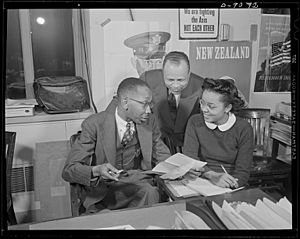Ted Poston facts for kids
Ted Poston (born July 4, 1906 – died January 11, 1974) was an American journalist and writer. He made history as one of the first African-American journalists to work for a major newspaper owned by white people, the New York Post. Many people called him the "Dean of Black Journalists" because he was so important in his field.
Contents
Early Life and First Steps
Ted Poston was born in Hopkinsville, Kentucky. His mother, Mollie Cox, passed away when he was ten years old. His eight older brothers and sisters mostly raised him. His father, Ephraim, taught at a college far away.
When he was just fifteen, Ted started writing articles. He wrote for his family's newspaper, the Hopkinsville Contender. This was the very beginning of his long career.
In 1928, he finished college at Tennessee Agricultural and Industrial College. After that, he moved to New York City to become a journalist.
A Career in Journalism
In 1928, Ted Poston became a reporter for the New York Amsterdam News. This was a weekly newspaper for the African-American community in Harlem, New York. By 1935, he became the editor of the paper. However, he was later fired for trying to start a union for his fellow reporters.
The next year, in 1936, the New York Post hired him temporarily. This made him only the third Black reporter to work for a big daily newspaper in New York City.
When he was sent to the New York City Police Department pressroom, other reporters would not talk to him. But at the Post, he was a star reporter. The newspaper's owner, Dorothy Schiff, liked his work a lot. Over the years, Ted used his influence with Ms. Schiff. He pushed for the newspaper to hire more Black and Puerto Rican reporters.
Covering Important Stories
During his thirty-five years at the Post, Ted Poston covered many important events. He reported on Jackie Robinson joining Major League Baseball. He also covered the Brown v. Board of Education case, which helped end segregation in schools. He followed the efforts of the Little Rock Nine to integrate schools in Little Rock, Arkansas. While covering the Little Rock Nine story in 1959, some white men shot at him.
He also covered the Scottsboro Boys trials. This was very difficult because authorities in Alabama would not let a Black journalist report in the segregated South. He had to pretend to be a preacher. He secretly turned in his stories with help from white colleagues. In 1949, white mobs chased him when he tried to cover the Groveland Four case in Lake County, Florida. He escaped safely and wrote a series of articles about the Groveland Case. The Post nominated him for a Pulitzer Prize for this work.
Working for the Government
During World War II, Ted Poston left New York for a short time. He worked for the United States Office of War Information in Washington, D.C. There, he helped connect the government with the Black community. He was part of Franklin D. Roosevelt's group of Black advisors, sometimes called the "Black Cabinet." After President Roosevelt died, Poston and other Black journalists urged Harry S. Truman to end segregation in the military.
Later Years
Ted Poston retired from the Post in 1972. He planned to work on a collection of short stories about his life. Sadly, he could not finish the book because of health problems from arteriosclerosis. He passed away on January 11, 1974, at his home in Bedford–Stuyvesant, Brooklyn.
Legacy and Recognition
Ted Poston was one of the first journalists to be honored in the National Association of Black Journalists Hall of Fame. This happened when it opened in 1990. In 1999, his articles about the Groveland Case were named one of the 100 most important journalism works of the 20th century. This honor came from New York University's School of Journalism. His book of short stories was published after he died in 1991. It was called The Dark Side of Hopkinsville.
Personal Life and Friendships
Ted Poston was married three times. He was friends with the famous writer Langston Hughes. In 1932, they traveled to the Soviet Union together. They were going to appear in a film against segregation. For many years, he also lived next door to his friend Thurgood Marshall, who later became a Supreme Court Justice.
Awards and Honors
- 1949 George Polk Award for National Reporting
- 1949 Heywood Broun Award
- 1972 Black Perspective award for Pioneering Journalists
- 1990 National Association of Black Journalists Hall of Fame inductee


